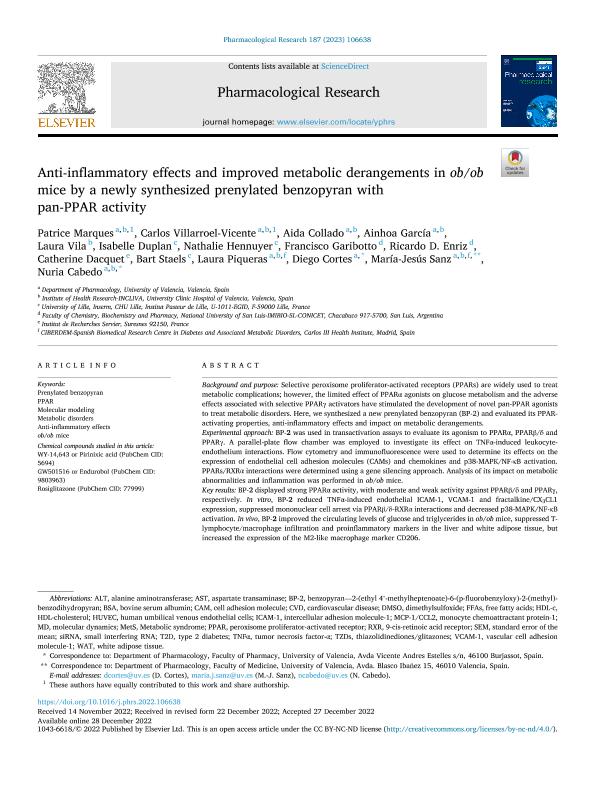Artículo
Anti-inflammatory effects and improved metabolic derangements in ob/ob mice by a newly synthesized prenylated benzopyran with pan-PPAR activity
Marques, Patrice; Villarroel Vicente, Carlos; Collado, Aida; García, Ainhoa; Vila, Laura; Duplan, Isabelle; Hennuyer, Nathalie; Garibotto, Francisco Matías ; Enriz, Ricardo Daniel
; Enriz, Ricardo Daniel ; Dacquet, Catherine; Staels, Bart; Piqueras, Laura; Cortes, Diego; Sanz, María Jesús; Cabedo, Nuria
; Dacquet, Catherine; Staels, Bart; Piqueras, Laura; Cortes, Diego; Sanz, María Jesús; Cabedo, Nuria
 ; Enriz, Ricardo Daniel
; Enriz, Ricardo Daniel ; Dacquet, Catherine; Staels, Bart; Piqueras, Laura; Cortes, Diego; Sanz, María Jesús; Cabedo, Nuria
; Dacquet, Catherine; Staels, Bart; Piqueras, Laura; Cortes, Diego; Sanz, María Jesús; Cabedo, Nuria
Fecha de publicación:
01/2023
Editorial:
Academic Press Ltd - Elsevier Science Ltd
Revista:
Pharmacological Research
ISSN:
1043-6618
Idioma:
Inglés
Tipo de recurso:
Artículo publicado
Clasificación temática:
Resumen
Background and purpose: Selective peroxisome proliferator-activated receptors (PPARs) are widely used to treat metabolic complications; however, the limited effect of PPARα agonists on glucose metabolism and the adverse effects associated with selective PPARγ activators have stimulated the development of novel pan-PPAR agonists to treat metabolic disorders. Here, we synthesized a new prenylated benzopyran (BP-2) and evaluated its PPAR-activating properties, anti-inflammatory effects and impact on metabolic derangements. Experimental approach: BP-2 was used in transactivation assays to evaluate its agonism to PPARα, PPARβ/δ and PPARγ. A parallel-plate flow chamber was employed to investigate its effect on TNFα-induced leukocyte-endothelium interactions. Flow cytometry and immunofluorescence were used to determine its effects on the expression of endothelial cell adhesion molecules (CAMs) and chemokines and p38-MAPK/NF-κB activation. PPARs/RXRα interactions were determined using a gene silencing approach. Analysis of its impact on metabolic abnormalities and inflammation was performed in ob/ob mice. Key results: BP-2 displayed strong PPARα activity, with moderate and weak activity against PPARβ/δ and PPARγ, respectively. In vitro, BP-2 reduced TNFα-induced endothelial ICAM-1, VCAM-1 and fractalkine/CX3CL1 expression, suppressed mononuclear cell arrest via PPARβ/δ-RXRα interactions and decreased p38-MAPK/NF-κB activation. In vivo, BP-2 improved the circulating levels of glucose and triglycerides in ob/ob mice, suppressed T-lymphocyte/macrophage infiltration and proinflammatory markers in the liver and white adipose tissue, but increased the expression of the M2-like macrophage marker CD206. Conclusion and implications: BP-2 emerges as a novel pan-PPAR lead candidate to normalize glycemia/triglyceridemia and minimize inflammation in metabolic disorders, likely preventing the development of further cardiovascular complications.
Archivos asociados
Licencia
Identificadores
Colecciones
Articulos(CCT - SAN LUIS)
Articulos de CTRO.CIENTIFICO TECNOL.CONICET - SAN LUIS
Articulos de CTRO.CIENTIFICO TECNOL.CONICET - SAN LUIS
Articulos(IMIBIO-SL)
Articulos de INST. MULTIDICIPLINARIO DE INV. BIO. DE SAN LUIS
Articulos de INST. MULTIDICIPLINARIO DE INV. BIO. DE SAN LUIS
Citación
Marques, Patrice; Villarroel Vicente, Carlos; Collado, Aida; García, Ainhoa; Vila, Laura; et al.; Anti-inflammatory effects and improved metabolic derangements in ob/ob mice by a newly synthesized prenylated benzopyran with pan-PPAR activity; Academic Press Ltd - Elsevier Science Ltd; Pharmacological Research; 187; 1-2023; 1-14
Compartir
Altmétricas



